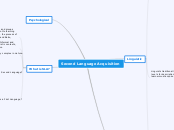Chapter 2 CR
Works Cited:
Rottenberg, Annette T. and Donna Haisty Winchell. "Chapter 2: Examining Written Arguments." Elements of Argument: A Text and Reader. 11th ed. Boston, MA: Bedford/St. Martins, 2015. 34-60. Print.
Making Notes
Similarities
It can be helpful to note similarities between your personal experiences or other texts and the text (Rottenberg and Winchell 41).
Structure and Interrogation
While you're reading, note how structural devices, such as transitional phrases, are used throughout the text. Also, note any interesting arguments made, whether you agree with them or not (Rottenberg and Winchell 41).
Marginal Notes
Underlining parts of the text and summarizing them in your own words is extremely useful for understanding a paper. Not only does it prove that you've comprehended to text, but it can be used at a later date to quickly review (Rottenberg and Winchell 40).
Summarizing
Toulmin Model
When summarizing a Toulmin model, look for what kind of claim he is making, such as a claim of fact, and what kind of support he is using, such as statistics (Rottenberg and Winchell 45).
Rogerian Argument
When summarizing a Rogerian argument, ask three questions. Is the opposing point of view presented as fairly as can be reasonably expected? Does the author attempt to establish common grounds between opposing viewpoints? Does the author attempt to create a compromise between opposing viewpoints (Rottenberg and Winchell 45)?
Aristotelian Rhetoric
When summarizing an Aristotelian rhetoric, look for three things: examples the author uses; when and how deductive reasoning is used; and, of course, the logos, pathos, and ethos (Rottenberg and Winchell 45).
Evaluating an Argument
Structure and Style
Evaluate the structure and style of the argument. The structure should go from idea to idea in a logical order. In addition, the style of the words used should properly convey the message to the expected audience (Rottenberg and Winchell 54).
Effectiveness
Think about how effective the title of the paper is at setting the tone and summarizing the point of the essay. Throughout the paper, the author should follow through on that point (Rottenberg and Winchell 54).
Strengths and Weaknesses
Consider both the strengths and the weaknesses of the argument. Look for the points that were successfully made and those that where based on faulty reasoning or insufficient evidence (Rottenberg and Winchell 53).
Viewpoints
Since you might have a different viewpoint from the author, it's fine to disagree with him or her, as long as you've read their argument and have your own proof. You can also furthur discuss the material with your peers (Rottenberg and Winchell 53).
Approaching an Argument
Topic
Skim the paper to get an overall idea for what the author is trying to get across. Focus on the topic sentences, which is usually the first sentence. Also, pay attention to visuals. They can help set or enhance the mood or tone of the argument. (Rottenberg and Winchell 40).
Prereading
Context
In an argument, the author must carefully consider who their audience is going to be and write accordingly. Use your understanding of the paper to try and gauge who they were writing for. This knowledge will help with grasping the context (Rottenberg and Winchell 35).
Author
As you read the paper, it's important to try to get a general idea of who the author is. You can do this in three ways: close reading of the text; discussion with peers; and simply researching them. The more you know about them, the more effecient your reading will be (Rottenberg and Winchell 35).
Understanding
To best understand the text, it's important to look at some of the background information. For example, when and where was the text published? Why was it written in the first place (Rottenberg and Winchell 35)?
Title
The title is just as important to the argument as the actual paper. Since it's probably the first part you'll read, it sets to tone for the rest of the argument (Rottenberg and Winchell 35).









